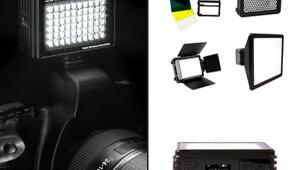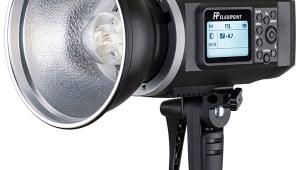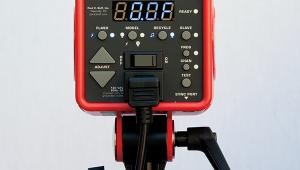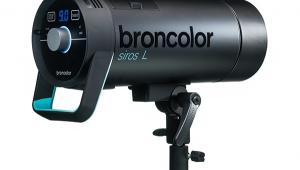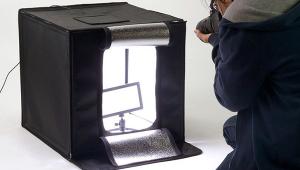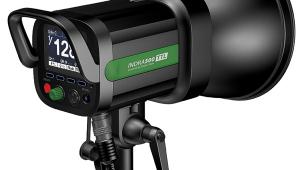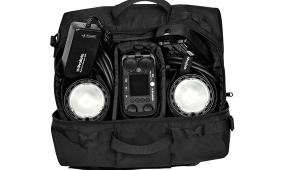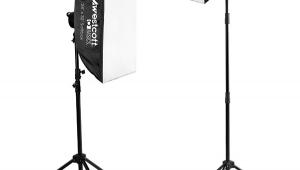Lowel GL-1 Power LED: A Portable, Versatile Continuous Light
The digital camera revolution has brought about many changes, not the least being the ability to photograph in low-light levels that were only wishful thinking a few years ago. That ability has also spawned significant changes in lighting equipment. In many cases, high-powered flash equipment is no longer needed when you can simply turn the ISO dial on your camera to achieve the desired f/stop. And with small product photography, it makes more sense for many of us to use inexpensive constant light sources rather than high-powered strobe setups. There’s no doubt that the trend to more constant light options in both daylight and tungsten color balance will continue.

That brings me to the Lowel GL-1 Power LED, a small yet powerful tungsten-balanced light aimed at the wedding and location photographer. Most wedding photographers group all lights like this under the heading “video light.” There are many small video lights in a wide range of prices available, but the GL-1 is a unique design with rugged build quality and several features that set it apart from the rest.

This image of Emily Mierswa was taken late in the day. I used the GL-1 in spot mode just out of the photo to the right and set my camera’s white balance to tungsten so the light on her face would be color correct but the surrounding lighting mood would be enhanced by a blue cast. Technical info: Nikon D300, ISO 200, Tamron 28-75mm f/2.8 lens at 28mm, 1/200 sec at f/4.5.
All Photos © Steve Bedell
Form And Function
The light was designed by well-known wedding photographers Brian Marcus and John Solano. They wanted a light with high power, constant color temperature, long battery life, and more. To that end, the GL-1 has light output comparable to a 100w tungsten halogen focused at the same beam angle. Its unique design mimics a power drill with the battery at the bottom, and a pistol grip with the light on top. You can focus the light beam by simply sliding the front housing forward and backward. There are markings on the side of the unit if you want to repeat a setting. The settings give you the option of using the light beam as either a spot or a broader flood.
The GL-1 also has a couple of options for dimming the light. That power drill-like trigger on the front varies the light intensity just by using finger pressure or you can lock in a setting by using the little wheel on the back part of the pistol grip. This is really handy when you use the light on a tripod. Just set the light up on a tripod, adjust the power and beam, and walk away. It acts like any other light on a light stand.

I let the camera pick the white balance by setting AWB. Merranda Donnely’s face came out a bit warm, but that could also have been influenced by the ambient light’s effect on the color reading. Light levels were low at dusk; light used on spot with my assistant keeping dry. Technical info: Nikon D3, ISO 800, Nikon 80-200mm f/2.8 lens at 92mm, 1/400 sec at f/3.5. Right: Full-Figure Light
This time I used the widest or flood setting on the GL-1 to light my entire subject (Merranda Donnely). White balance and exposure on auto. Technical info: Nikon D3, ISO 800, Nikon 50mm f/1.8 lens, 1/160 sec at f/3.5.

I packed the GL-1 in my suitcase and brought it to Minnesota for Kathleen Johnson’s wedding. This was taken at night in the hotel atrium. I had a tall guy hold the light high and toward the couple and balanced the exposure with the ambient light. Technical info: Nikon D300, ISO 2000, Sigma 17-35mm lens, 1/40 sec at f/4.
Power Sources
To charge the included battery, you remove it from the base and use the supplied charging cord. A drained battery takes about two to three hours to charge and will last for about an hour at full power. Once you slide the battery into the GL-1, you hit the rocker switch on the base and there are power indicator lights to advise you of remaining power. The GL-1 also comes with a power cord so you can also use it with AC power, as I did in the studio. There is a cooling fan that is very quiet. The front of the light accepts 82mm screw-thread accessories, especially useful if you want to use an 82B filter to convert to daylight balance.

For this image of Raven in the studio I used a tripod-mounted GL-1 and another modeling light on the background to add some interest. Note the high ISO required. Technical info: Nikon D3, ISO 3200, Nikon 80-200mm f/2.8 lens at 80mm, 1/200 sec at f/3.2.
Tests
I used the GL-1 on model shoots, at a wedding, and even had some fun with light painting. The unit proved very sturdy, weighing almost 4 lbs with the battery, and performed flawlessly. I expect it will last for a long time with proper care. The pistol grip design allows anyone to pick up the light and aim it without worrying about getting their fingers burned by the heat usually associated with video lights.
All in all, the combination of a dimmable light with a relatively long battery life and a focusing Fresnel lens makes this a winner for photographers on the go.

Many years ago I used to light paint big pieces of machinery in factories by dressing in dark clothes and popping off a small flash unit many times as I walked around lighting the different areas. I used the same technique here with the constant source GL-1. I parked my car in the driveway and used a 30-second exposure as I walked around the car and lit the car, house, trees, and foreground branches. I opened and closed the car door first so the interior and parking lights would remain on for a few seconds. The star effect is natural, not added. I did use LucisArt software to bump up contrast and add punch to the image. Technical info: Nikon D3, ISO 200, Sigma 17-35mm lens at 27mm, 30 seconds at f/8.
The Lowel GL-1 Power LED has a street price of $699. For more information and full specs, contact Lowel at www.lowel.com/GL.


